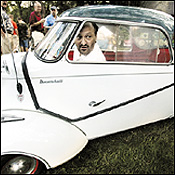More smiles per gallon
By Daniel E. Black/ Staff Writer
Wednesday, July 12, 2006
By all accounts, it smelled and sounded like a John Deere convention.
The
lawnmower-sized, one- and two-cylinder engines sputtered, hummed and
propelled more than 100 miniature, post-World War II vehicles around
Newton and Brookline last weekend during the 11th annual Microcar and
Minicar Classic.
Buzzing
through the streets of Oak Hill on Friday night, little-car aficionado
and event organizer Charles Gould blissfully zipped around corners in a
three-wheeled 1961 Messerschmitt. The low-slung two-seater (positioned
in tandem rather than side-by-side), looked one part go-cart and two
parts fighter jet. The steering wheel was lifted directly from a jet
and the cockpit of the car was covered by a Plexiglas bubble while
riding on eight-inch tires.
While
it doesn’t fly, the car can move. With two adults in the vessel, Gould
said the top speed is 62 miles per hour.
On
Friday night about 100 people met at Gould’s home in Newton to share
stories over drinks and food. Saturday afternoon featured a show at the
Larz Anderson Museum in Brookline which allowed visitors to take a ride
in some of the vehicles.
The
entrance to the museum property was watched over by Ihsan Ali, 17, the
quarterback of the Brookline High football team. Ali, who works in the
summer at the Larz Anderson Museum, is on hand for most of the car
shows, and said this event draws the nicest crowds.
But, he couldn’t stop asking where these cars have been his whole life.
"I’ve never seen these cars before," Ali said. "Where do they keep them?"
The
mini cars were developed after WWII, when companies that had built
fighter jets were prohibited from continuing production. As a
replacement, the industry shifted to creating inexpensive, lightweight,
small vehicles, originally designed for injured veterans.
However,
their appeal quickly spread. Messerschmitt, just one of several dozen
manufacturers, built over 120,000 vehicles alone.
"These
cars changed the socioeconomic atmosphere in Europe in the 1950s,"said
Gould, a lawyer who lives in Oak Hill. "It’s an important and unknown
chapter in automotive history."
The three-wheeled vehicles were registered as motorcycles, making them even more affordable.
"People ask, 'Is it real? Is
it a toy? Is it legal?' "Gould said. "I say, 'Yes' to all three."
Gould
and his wife Nancy left the elite car collecting world more than two
decades ago, switching their allegiance to the whimsical and absurd
genre of micro cars. They haven’t looked in their rear view mirror
since.
"We
love these cars and we love the people that own these cars," Nancy said
last weekend during the country’s largest annual gathering of mini and
micro cars. "It’s like a family reunion."
It’s a family that features a diverse background of members.
Take
Mark Nelson, an electrical engineer from Natick, Kevin George, an
automotive interior repairman from Wellford, South Carolina or Ralph
Hough, a retired policeman from Ontario, Canada. They each own mini
cars: George has several, including spare parts from incomplete models,
and Hough has seven. They each had big dreams to own these tiny cars.
"I
always like all sorts of weird cars, and all of these cars qualify,"
Nelson, 58, said as he stood beside his bright red 1960 Goggomobil
coupe, which tips the scales at just under 1,000 pounds, is less than
five feet wide and comes with the "big" engine option: a 20-horsepower,
two-stroke, two-cylinder model. All for $7,500, and another $1,000 to
have the vehicle shipped from California to Massachusetts.
While
he’s made some repairs to the front shocks and clutch - "it’s a
45-year-old car," he says - it generally runs smoothly.
"My goal is to drive it to Cape Cod," he said.
But, no matter where he’s going, the car elicits the same response from viewers.
"It makes people smile," Nelson said. "They do a double take and then smile." "It makes people smile," Nelson said. "They do a double take and then smile."
Ralph
Hough and his wife, Wendy, were married in 1963 and toured Europe, on
their honeymoon, in a Messerschmitt. They even belonged to a
Messerschmitt club. Ralph drove down from Ontario, Canada along with
his son, Richard, and grandson, Spencer to partake in the Gould’s
weekend event.
That
Messerschmitt was sold a long time ago. However, in 1990, Ralph retired
as a police officer and bought a Messerschmitt, which he planned to
trailer behind an RV. He never got the RV, and now he has a ’Schmitt
House in his back yard, which stores his two BMW Isettas, two BMW 600s,
and five Messerschmitts.
"Wherever
you go, people take pictures," Richard said. "It’s unique. It’s not
your typical ’57 Chevy. A lot of people have never seen these kinds of
things."
Ralph’s
favorite is the four-wheeled, bright blue Messerschmitt Tiger - "the
ultimate collector micro car," he said - and at $45,000 to $50,000
they’re not cheap to acquire.
The
first car of any size that Kevin George, 49, owned was a Vespa 400, a
car slightly smaller than Nelson’s diminutive Goggomobil. George bought
it for $10 when he was 16 and after making repairs to it, sold it for
$200.
Two
and a half decades passed before he got back into a mini car. It took
him another three years of searching before he found one of the four
remaining Biscuter Pegasins still in existence.
Though
the car gets between 55 and 60 miles per gallon, it usually takes
George 30 minutes to fill the tiny tank - people at the pumps are
always asking questions.
Because
the Pegasin is so rare, the once-affordable vehicle could now fetch
$20,000 to $40,000 on the market.
"These cars bring more smiles per dollar than any others," said Nancy Gould.
|
|

Charles
Gould, organizer of the 11th annual Microcar and Minicar Classic, sits
in his three-wheeled 1961 Messerschmitt. (Photo By Matthew Healey) |
|

